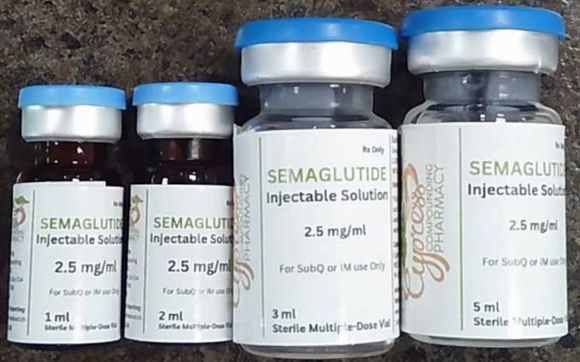Have you ever found yourself staring at your pharmacy bill, wondering if there’s a more affordable way to get your medications?
If you’re considering semaglutide for weight loss, you might have heard whispers about compound pharmacy semaglutide as a potential money-saver.
But is it really cheaper? Let’s dive into the world of pharmaceutical economics and uncover the truth about semaglutide costs.
The Semaglutide Sensation: A Quick Recap
Before we start comparing prices, let’s refresh our memory about semaglutide. It’s the new kid on the block in the weight loss world, and boy, has it made a splash!
Originally developed for diabetes treatment, semaglutide has become a go-to option for those struggling with obesity. But with great effectiveness comes… great expense?
Commercial Semaglutide: The Name Brand Giant
When we talk about commercial semaglutide, we’re referring to brand names like Wegovy® and Ozempic®.
These are the sleek, marketed versions you see in TV ads and glossy magazines. But what’s the damage to your wallet?
The Price Tag of Popular Brands
| Brand Name | Average Monthly Cost (without insurance) |
| Wegovy® | $1,300 – $1,500 |
| Ozempic® | $900 – $1,100 |
Ouch! Those numbers might make your eyes water. But why so pricey? Here’s the breakdown:
- Research and development costs: Pharmaceutical companies spend billions bringing new drugs to market.
- Marketing expenses: Those catchy commercials aren’t cheap!
- Patent protection: Limited competition allows for higher pricing.
- Quality control: Rigorous testing and standardization add to the cost.
It’s enough to make you consider a second job just to lose a few pounds, right? But hold on, there might be another option…
Enter the Underdog: Compounded Semaglutide
Now, let’s talk about compound pharmacy semaglutide. It’s like the indie band of the pharmaceutical world – not as flashy, but with a devoted following. But what exactly is it?
Compounded semaglutide is created by specialized pharmacies that mix the active ingredient (semaglutide) with other components to create a customized medication. It’s like getting a bespoke suit instead of buying off the rack.
The Potential Savings
Here’s where things get interesting. Compounded semaglutide often comes with a significantly lower price tag:
| Type of Semaglutide | Average Monthly Cost |
| Compounded | $200 – $500 |
Wow! That’s quite a difference, isn’t it? But before you rush to your nearest compound pharmacy, let’s break down why it’s cheaper:
- Lower overhead costs: No fancy packaging or marketing campaigns.
- Bulk ingredient purchases: Compounding pharmacies can buy semaglutide in larger quantities.
- Customized dosing: You only pay for what you need.
- Less regulatory burden: While still regulated, compounding pharmacies face fewer hurdles than big pharma.
Sounds too good to be true? Well, as with most things in life, there are pros and cons to consider.

The Pros and Cons: A Balancing Act
Let’s weigh the advantages and disadvantages of choosing compounded semaglutide:
Pros of Compounded Semaglutide:
- Lower cost: More affordable for many patients.
- Customization: Dosages can be tailored to individual needs.
- Flexibility: Can be compounded with other medications.
- Availability: May be easier to obtain than commercial versions.
Cons of Compounded Semaglutide:
- Lack of FDA approval: Not evaluated for safety and efficacy by the FDA.
- Variability: Quality and potency may vary between pharmacies.
- Insurance coverage: Often not covered by insurance plans.
- Limited research: Fewer studies on long-term effects and outcomes.
It’s like choosing between a designer handbag and a handmade one. Both have their merits, but it depends on what you value most.
The Hidden Costs: What You Might Not See on the Price Tag
Now, let’s dig a little deeper. The sticker price isn’t always the whole story. Here are some factors that might influence the true cost of your semaglutide treatment:
- Insurance coverage: Some plans may cover commercial versions but not compounded ones.
- Dosage differences: Compounded versions might require different dosing schedules.
- Additional testing: Your doctor might recommend more frequent check-ups with compounded medications.
- Long-term efficacy: If the compounded version is less effective, you might need treatment for a longer period.
Remember, the cheapest option isn’t always the most cost-effective in the long run. It’s like buying a cheap pair of shoes – if they wear out quickly, you might end up spending more on replacements.
The Legal Landscape: Navigating Murky Waters
Here’s where things get a bit tricky. The legal status of compounded semaglutide is… complicated. Let’s break it down:
- FDA stance: The FDA hasn’t approved compounded semaglutide for weight loss.
- State regulations: Some states have stricter rules on compounding than others.
- Prescriber responsibility: Doctors must ensure they’re prescribing within legal boundaries.
It’s like driving in a foreign country – the rules might be different from what you’re used to. Always consult with a healthcare professional to ensure you’re on the right side of the law.
Quality Considerations: You Get What You Pay For?
Now, let’s talk quality. Is compounded semaglutide as good as the commercial stuff? Here’s what you need to know:
- Ingredient sourcing: Compounding pharmacies should use high-quality, pharmaceutical-grade ingredients.
- Sterility: Proper compounding techniques are crucial for safe medication.
- Potency testing: Reputable pharmacies will test their compounds for accuracy.
- Expiration dates: Compounded medications may have shorter shelf lives.
It’s like comparing homemade cookies to store-bought ones. Homemade can be amazing, but you need to trust the baker’s skills and ingredients.
Making the Choice: What’s Right for You?
So, how do you decide between commercial and compounded semaglutide? Here are some questions to ask yourself:
- Is cost your primary concern?
- How important is FDA approval to you?
- Do you need a customized dosage?
- What does your insurance cover?
- How comfortable are you with potential variability in medication?
Remember, there’s no one-size-fits-all answer. It’s about finding the right balance for your health, wallet, and peace of mind.
The Future of Semaglutide: What’s on the Horizon?
Before we wrap up, let’s take a quick peek into the crystal ball. What might the future hold for semaglutide costs?
- Generic versions: As patents expire, cheaper generic options may become available.
- New competitors: Other weight loss medications might enter the market, potentially driving down prices.
- Improved compounding regulations: Stricter oversight could increase quality but also costs of compounded versions.
- Insurance changes: More plans might start covering weight loss medications.
Keep an eye on these developments – they could significantly impact your treatment options and costs in the coming years.
Conclusion: Balancing Health and Wealth
As we’ve seen, the cost comparison between compounded and commercial semaglutide isn’t just about numbers. It’s a complex dance of quality, legality, effectiveness, and personal needs.
Here’s your takeaway checklist:
- ✅ Compare costs, but look beyond the price tag
- ✅ Consult with healthcare professionals about safety and efficacy
- ✅ Consider your insurance coverage and long-term treatment plans
- ✅ Stay informed about legal and regulatory changes
- ✅ Prioritize your health and safety above all else
Remember, the cheapest option isn’t always the best, and the most expensive isn’t always necessary. Your health journey is unique, and so should be your approach to medication.

